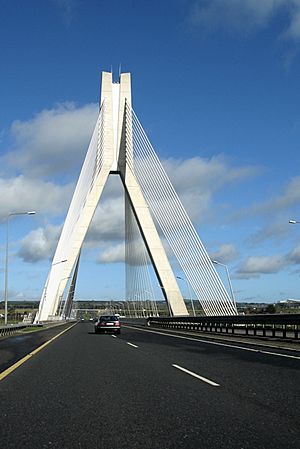Mary McAleese Boyne Valley Bridge facts for kids
Quick facts for kids Mary McAleeseBoyne Valley Bridge |
|
|---|---|

M1 traffic crossing the bridge
|
|
| Coordinates | 53°43′04″N 6°23′48″W / 53.717866°N 6.396704°W |
| Carries | Four lanes |
| Crosses | Boyne River |
| Locale | County Louth, 3 km west of Drogheda |
| Named for | Mary McAleese's peace process as President from 1997 to 2011 |
| Maintained by | Celtic Roads Group |
| Characteristics | |
| Design | Cable-stayed bridge |
| Total length | 352.5 m |
| Width | 34.5 m |
| Height | 95 m |
| Longest span | 170 m |
| Number of spans | 6 |
| Piers in water | 0 |
| Clearance above | 20 m |
| History | |
| Designer | Roughan & O'Donovan |
| Construction begin | May 2000 |
| Construction end | 2003 |
| Opened | 9 June 2003 |
The Mary McAleese Boyne Valley Bridge is a special type of bridge in Ireland. It is known as a cable-stayed bridge. This means its main deck is held up by strong cables. These cables connect to tall towers or pylons. The bridge crosses the River Boyne about 3 kilometers west of Drogheda. It links County Meath and County Louth. This important bridge is part of the M1 Northern Motorway.
When it opened in June 2003, it was the longest cable-stayed bridge in Ireland. This record was held until 2009. The bridge was built between 2000 and 2003. Roughan & O'Donovan consulting engineers designed it. They even won an award for their design in 2005.
Contents
Building the Boyne Valley Bridge
Building a bridge over the Boyne River was a big challenge. The land on the south side was high and dropped suddenly. The north side sloped gently down to the river. The area is also very important for nature. There are reed beds and an island with special plants and animals. The famous Battle of the Boyne happened nearby in 1690. This made the area historically important too.
Why a Cable-Stayed Design?
Engineers chose a cable-stayed bridge for several reasons. This design allowed for a very long main span. This meant no supports were needed in the river. This protected the river and the island's wildlife. Even though it cost more, it was the best choice. The bridge also looks very impressive. It has a tall pylon on the south side. Cables fan out from it, holding up the bridge deck.
How the Bridge Was Built
Cleveland Bridge U.K. Ltd. built the bridge. They used a special method called "incremental launching." This was the first time this method was used for a cable-stayed bridge. It means sections of the bridge were pushed out from one side. Construction started in May 2000. The bridge officially opened on June 9, 2003.
Managing the Bridge
The bridge is managed by a company called Celtic Roads Group. This is a partnership with the Irish Government. The company is responsible for keeping the road in good condition for 30 years. To help pay for building and maintaining the bridge, drivers pay a toll. This toll is collected in both directions. In 2006, the bridge won an award for its excellent design.
Naming the Bridge
In 2012, there was a proposal to rename the bridge. Meath County Council suggested naming it after Mary McAleese. She was the President of Ireland from 1997 to 2011. The council wanted to honor her work for peace in Northern Ireland.
A New Name for the Bridge
At first, the name "Mary McAleese Bridge" was suggested. But some people felt the name should also include the local area. So, on June 8, 2013, a special ceremony was held. The bridge was officially renamed the Mary McAleese Boyne Valley Bridge. This new name honors both the former President and the beautiful Boyne Valley.

